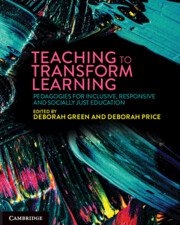Book contents
- Teaching to Transform Learning
- Acknowledgement of Country
- Teaching to Transform Learning
- Copyright page
- Contents
- Contributors
- Acknowledgements
- Introduction Understanding the learner to inform educators’ implementation of pedagogical approaches to transform learning
- Part 1 Pedagogies for all
- 1 Aboriginal pedagogies: exploring Indigenous ways of knowing, being and doing
- 2 Making lifeworld connections through critical pedagogies
- 3 Culturally responsive pedagogies: learners as assets
- 4 Traversing identities: navigating the self, school and system for culturally responsive pedagogies
- 5 Culturally and religiously responsive pedagogy: a case study of enabling pedagogy for superdiverse Australian classrooms
- 6 Enabling pedagogy and critical teaching approaches in diverse learning contexts
- 7 Pedagogy of hospitality
- Part 2 Engaging pedagogies: making the curriculum come alive for all learners
- Part 3 Empowering pedagogies: 21st-century skill development and 22nd-century futures thinking
- Index
- References
5 - Culturally and religiously responsive pedagogy: a case study of enabling pedagogy for superdiverse Australian classrooms
from Part 1 - Pedagogies for all
Published online by Cambridge University Press: 25 October 2024
- Teaching to Transform Learning
- Acknowledgement of Country
- Teaching to Transform Learning
- Copyright page
- Contents
- Contributors
- Acknowledgements
- Introduction Understanding the learner to inform educators’ implementation of pedagogical approaches to transform learning
- Part 1 Pedagogies for all
- 1 Aboriginal pedagogies: exploring Indigenous ways of knowing, being and doing
- 2 Making lifeworld connections through critical pedagogies
- 3 Culturally responsive pedagogies: learners as assets
- 4 Traversing identities: navigating the self, school and system for culturally responsive pedagogies
- 5 Culturally and religiously responsive pedagogy: a case study of enabling pedagogy for superdiverse Australian classrooms
- 6 Enabling pedagogy and critical teaching approaches in diverse learning contexts
- 7 Pedagogy of hospitality
- Part 2 Engaging pedagogies: making the curriculum come alive for all learners
- Part 3 Empowering pedagogies: 21st-century skill development and 22nd-century futures thinking
- Index
- References
Summary
This chapter responds to an often-overlooked issue in Australian public schooling’s commitment to equity, that is, ‘religion’, or more precisely, educator’s ‘responsivity’ to the religious identities and knowledges of learners. The shared focus of this book is commitment to equity and pedagogies that transform learning and muster approaches to a more inclusive, responsive and socially just education. We argue for a widening of educational pedagogy. In this chapter, we center Muslim learners as a case study for enabling pedagogies for superdiverse Australian classrooms. We argue for culturally and ‘religiously’ responsive pedagogy (CRRP) as a powerful means of shifting away from established pedagogies that often erase religion from classrooms. This chapter considers the role of enabling pedagogical approaches that are responsive to the lifeworlds of Muslim learners and their religious backgrounds; that view religion as a form of learner diversity and thus assets for learning; that provide equitable opportunities and high expectations for all learners; and that prepare respectful spaces that allow for ‘sensitive’ and controversial dialogue, mediation of difference and criticality so all learners may engage with societal change.
Keywords
- Type
- Chapter
- Information
- Teaching to Transform LearningPedagogies for Inclusive, Responsive and Socially Just Education, pp. 75 - 91Publisher: Cambridge University PressPrint publication year: 2024

